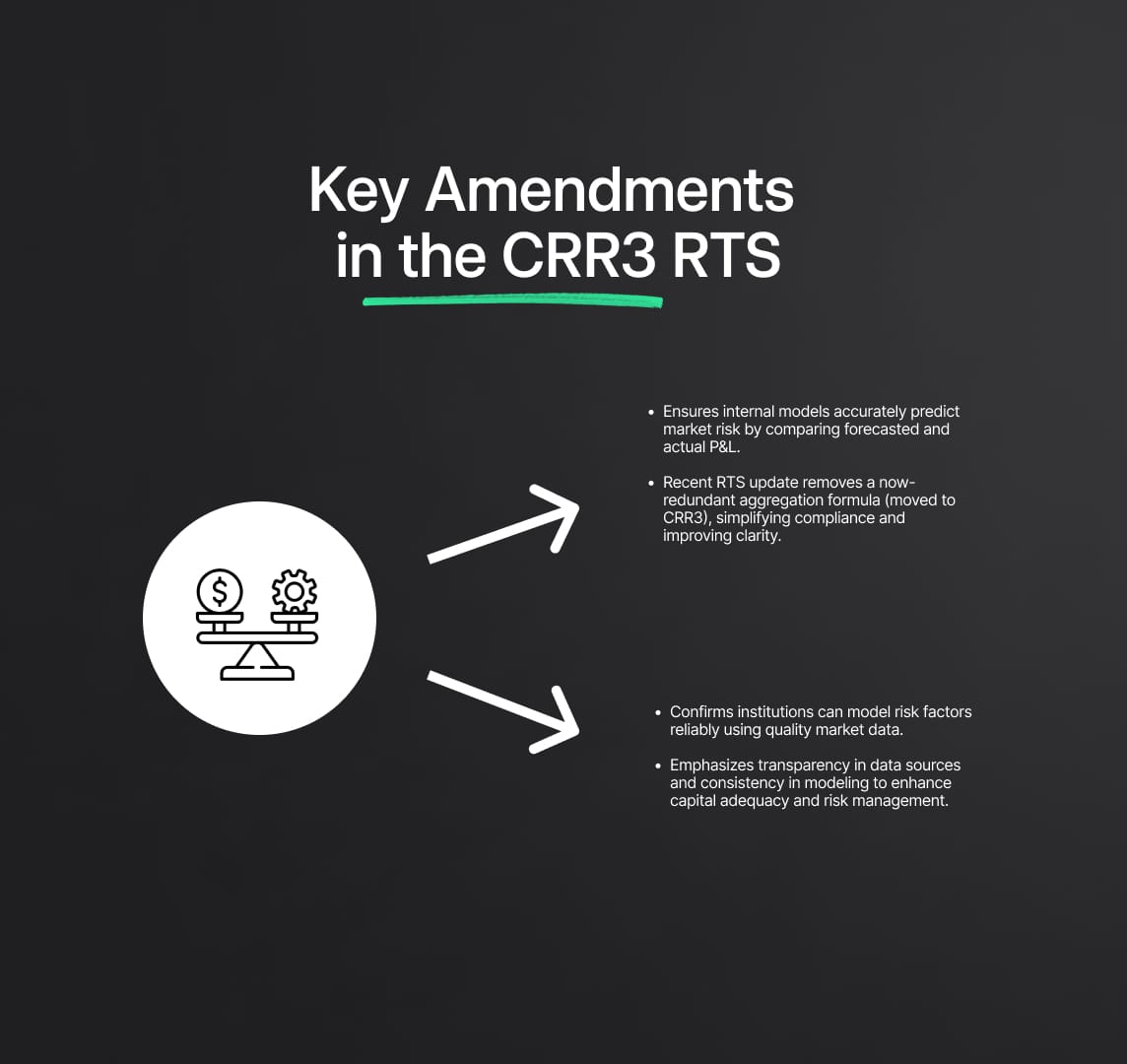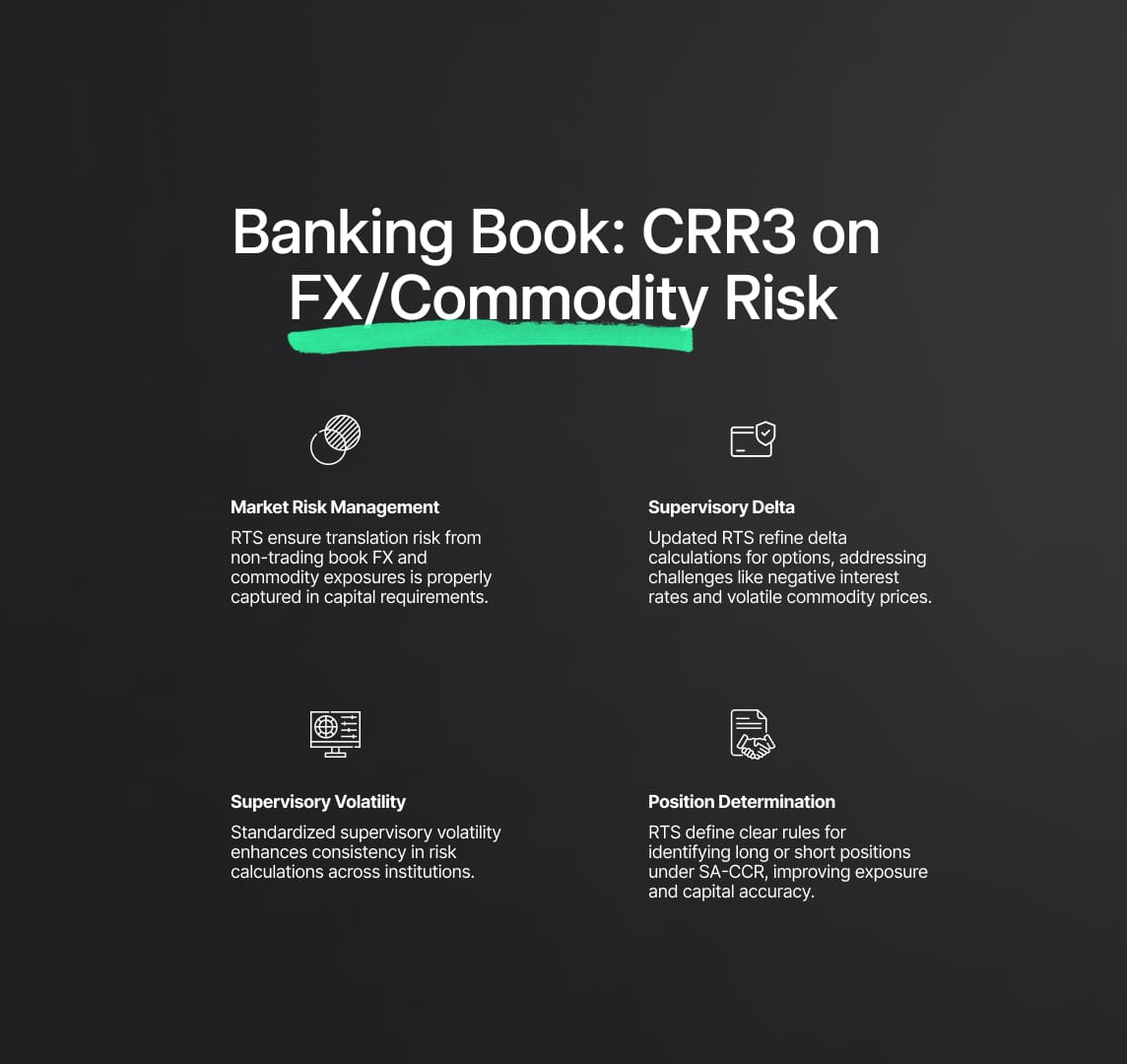Market Risk Management Under CRR3
The EBA's RTS are crucial for maintaining EU financial stability, ensuring robust risk management in evolving market conditions. The latest amendments under CRR3 refine methodologies for market risk assessment, enhancing accuracy, consistency, and resilience across financial institutions.

The European Banking Authority (EBA) has undertaken substantial efforts to refine and update its Regulatory Technical Standards (RTS) to align with the rapidly evolving regulatory environment in the European Union. These revisions, driven by the Capital Requirements Regulation 3 (CRR3), are essential for maintaining financial stability and ensuring that EU banks remain resilient amidst increasingly complex market risks. The amendments published by the EBA in December 2023 and August 2024 are particularly significant, focusing on the Fundamental Review of the Trading Book (FRTB) and the Standardised Approach for Counterparty Credit Risk (SA-CCR). This analysis delves into these amendments, examining their legal foundation, key provisions, and the broader implications for financial institutions.
Legal Basis and Regulatory Background
The EBA's amendments to the RTS are deeply rooted in the legislative mandates established by the Capital Requirements Regulation 2 (CRR2) and expanded under CRR3. Initially, CRR2 introduced the Fundamental Review of the Trading Book into EU law, prompting the EBA to develop a comprehensive set of RTS aimed at ensuring robust risk management across EU financial institutions. These standards focused on critical areas such as back-testing, profit and loss attribution (PLA), risk factor modellability, and the management of foreign exchange (FX) and commodity risks within the banking book.
CRR3 further refines these requirements, necessitating the EBA to revise existing RTS to maintain consistency with the updated regulatory framework. The relevant articles under CRR3—specifically Articles 325(9), 325be(3), and 325bg(4)—authorize the EBA to establish detailed technical standards. These standards play a crucial role in guiding financial institutions on methodologies for calculating market risk capital requirements, assessing the model lability of risk factors, and conducting PLA tests. These amendments are a critical component of the broader EU Banking Package roadmap, designed to enhance the robustness and resilience of the financial system across the European Union.
Source
[1]

[2]


Key Amendments in the CRR3 RTS
1. Profit and Loss Attribution (PLA) Requirements
The PLA requirements are a cornerstone of the FRTB framework, designed to ensure that the internal models used by banks accurately capture the market risks they are intended to manage. Under Article 325bg of CRR3, the EBA is tasked with developing RTS that implement the PLA requirement within the EU. The PLA test is a critical tool, comparing the profits and losses predicted by a bank's internal models against actual outcomes. This comparison is vital for validating the reliability and accuracy of these models, ensuring they perform as expected under real market conditions.
A significant update in the RTS is the removal of the aggregation formula previously used to compute total own funds requirements for market risk. This formula, now directly incorporated into CRR3, was deemed redundant within the RTS framework. By eliminating this formula, the EBA has streamlined the PLA process, reducing regulatory complexity and ensuring better alignment with the CRR3 framework. This change not only simplifies compliance but also enhances the overall clarity and effectiveness of the RTS.
The PLA test remains a stringent measure of a bank’s internal model performance, requiring banks to demonstrate that their models can reliably predict daily profit and loss outcomes. This is critical for maintaining the integrity of risk management practices. By subjecting these models to rigorous testing and validation, the EBA aims to foster a more resilient banking sector capable of withstanding market shocks and volatility.
2. Risk Factor Modellability Assessment
The assessment of risk factors' modellability is another cornerstone of the RTS amendments, playing a critical role in the FRTB framework. Modellability refers to a financial institution's ability to reliably model a risk factor based on available market data. This capability is essential for the accurate calculation of capital requirements under internal models used to manage and mitigate market risks.
Article 325be of CRR3 mandates the EBA to specify criteria for assessing the modellability of risk factors, particularly when relying on external market data. The updated RTS emphasise the importance of transparency in this process, especially regarding the extent to which institutions depend on third-party vendors for the data necessary to assess modellability. This transparency is crucial for several reasons:
Data Reliability and Accuracy: Institutions must ensure that the data used for modellability assessments is reliable, accurate, and representative of market conditions. This is particularly important in scenarios where market data may be sparse or inconsistent, potentially leading to an underestimation of the risks associated with certain factors.
Mitigating Risks of Data Misalignment: By understanding their reliance on external data providers, institutions can better assess the risks of data misalignment between their internal models and external market data. Such misalignments can significantly affect the accuracy of risk assessments and, consequently, the capital institutions are required to hold.
Consistency in Risk Modeling: The RTS require that institutions maintain consistency in their risk modeling practices, ensuring that all risk factors included in their internal models meet the specified modellability criteria. This consistency is vital for the integrity of the overall risk management framework, helping to prevent unforeseen risks due to inadequate or unreliable modeling.
The emphasis on modellability within the RTS is a direct response to the complexities of modern financial markets, where the availability and quality of market data can vary significantly. By setting clear and stringent criteria for modellability, the EBA aims to enhance the accuracy and reliability of the internal models used by financial institutions, thereby strengthening the overall resilience of the banking sector.

CRR3: Treatment of Foreign Exchange and Commodity Risk in the Banking Book
The treatment of FX and commodity risk within the banking book is another critical area addressed by the updated RTS. Under Article 325 of CRR3, the EBA is required to develop detailed RTS outlining how institutions should calculate their own funds requirements for market risks associated with non-trading book positions.
The revised RTS place a particular focus on translation risk, which is the risk associated with converting the financial statements of foreign subsidiaries into the reporting currency. This risk can significantly impact the financial stability and capital adequacy of globally active banks, particularly during periods of volatile exchange rates. The updated RTS ensure that translation risk is adequately captured and managed, providing a more comprehensive framework for treating FX and commodity risks within the banking book.
By addressing translation risk, the EBA aims to ensure that banks hold sufficient capital to cover potential losses arising from adverse movements in exchange rates or commodity prices. This is particularly important for non-trading book positions, which, although traditionally considered less volatile than trading book positions, can still pose significant risks under certain market conditions.
The RTS also align capital requirements for these risks with broader financial stability and resilience objectives. By setting clear guidelines for treating FX and commodity risks, the EBA helps create a more robust and stable financial system, capable of withstanding external shocks and maintaining its integrity in the face of global economic challenges.
4. Calculation of Supervisory Delta and Volatility
The EBA's amendments to the RTS introduce refined methodologies for calculating the supervisory delta of call and put options, particularly in complex scenarios where traditional models might fall short. These scenarios include environments with negative interest rates or commodity prices, which have become increasingly relevant in today's volatile financial landscape. The supervisory delta is crucial in the Standardised Approach for Counterparty Credit Risk (SA-CCR), as it quantifies the sensitivity of an option's value to changes in the price of the underlying asset, influencing the calculation of exposure amounts.
The new RTS provide specific formulas tailored to address the challenges posed by negative interest rates and commodity prices. Traditionally, models used to calculate the delta assume positive interest rates and stable commodity prices. However, the global financial environment has shifted, with certain regions experiencing prolonged periods of negative rates and commodities like oil experiencing sharp price declines. These conditions necessitate adjustments to the delta calculation to accurately reflect the risks associated with options in such markets.
To ensure consistency and accuracy, the RTS specify the appropriate supervisory volatility that should be applied across portfolios when calculating the delta. Supervisory volatility is a standard measure used to capture the uncertainty or risk of price changes in the underlying asset over a specified period. The RTS mandate that this measure be consistent across all institutions, ensuring a level playing field and comparability in risk assessments. By standardizing the approach to supervisory volatility, the EBA aims to prevent discrepancies in how institutions assess and report their market risks, thereby enhancing the overall stability of the financial system.
These amendments also underscore the importance of adapting risk management practices to reflect current market conditions. For institutions operating in markets with unconventional economic conditions, such as negative interest rates, the revised RTS provide the necessary tools to accurately model these risks. The formulas and methodologies outlined in the RTS are not only technical enhancements but also strategic responses to the evolving financial environment, ensuring that institutions remain resilient and adequately capitalized in the face of new challenges.
5. Determination of Long or Short Positions
In addition to the enhanced calculations for supervisory delta and volatility, the EBA's draft RTS introduce a clear method for determining whether a transaction constitutes a long or short position in the primary or most material risk driver. This determination is critical under the SA-CCR framework, as it directly impacts how institutions calculate their exposure amounts and, consequently, their capital requirements for counterparty credit risk.
A long position in a risk driver implies that the value of the position increases as the price of the underlying asset rises, while a short position implies the opposite. Accurately classifying positions as long or short is essential because it affects the potential loss an institution might face in adverse market conditions. Misclassifying a position can lead to either overestimating or underestimating the capital required to cover potential losses, which can significantly impact an institution's risk management and capital adequacy.
The RTS provide a detailed methodology for this classification process, ensuring that institutions follow a consistent approach in determining the nature of their positions. This involves assessing the primary risk driver of the transaction, which is the risk factor that has the most.
Reduce your
compliance risks


